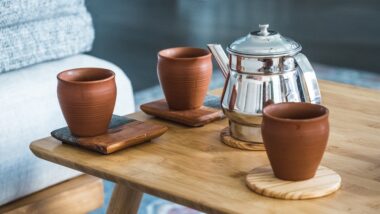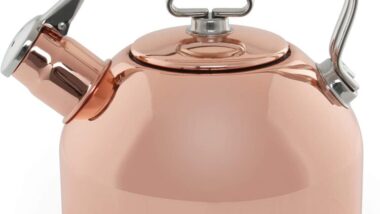Tea Kettle Not Whistling
Does your tea kettle not whistling when it’s ready? You’re not alone! Many people find this problem to be a common issue. It can be frustrating and confusing, but don’t worry – there are several possible solutions.
In this article, we’ll look at some of the most common causes of tea kettles not whistling, and how to fix them. Read on to learn more!
Tea Kettle Not Whistling – Clogged Spout
If your tea kettle isn’t whistling, it may be due to a clogged spout. This is quite common and can happen if tea leaves or other debris have become trapped in the spout opening.
Fortunately, this is a fairly easy fix. Start by making sure that the lid of the tea kettle is open. Then, use a toothpick to carefully remove any visible debris from the spout.
If there’s still something clogging up the spout, try pouring some warm water into it to help loosen anything that might be stuck inside. It may also help to use a cotton swab or pipe cleaner to gently scrub away any additional residue.
Once you’ve cleared out any blockages, your tea kettle should be ready to whistle again!
Blocked Whistle Valve
Continuing from the previous section, a clogged spout could be causing the tea kettle not to whistle.
Another possible cause of the issue is a blocked whistle valve.
The valve is what allows steam to escape and produce a whistling sound when the water boils.
If this valve is blocked, it will prevent the release of steam and thus stop any whistling noise from occurring.
To check if the whistle valve is blocked, try gently cleaning it with a paper clip or toothpick.
If that doesn’t work, carefully remove the valve from its seat to check for any blockage or debris that may be preventing proper airflow.
Once the blockage has been cleared, reattach the valve and test out your tea kettle to see if it’s now producing a whistling sound.
Wrong Type Of Kettle
When it comes to tea kettles, there’s a few things that could be causing your kettle not to whistle.
It could be the wrong type of kettle.
If you’re using an electric or induction stovetop kettle, it won’t whistle. Electric and induction stove top kettles have an automatic shut-off feature when the water reaches boiling temperature, so there’s no need for them to whistle.
But if you’re using a traditional stovetop kettle, it should be whistling when the water is hot enough.
So it might be time to switch out your electric or induction kettle for a more traditional one.
Make sure you read up on how to properly use your new tea kettle before brewing up your next cup of tea; different kettles require different techniques in order to get the best cup of tea possible.
And with proper care and maintenance, your traditional tea kettle will keep whistling for years to come!
Incorrect Temperature Setting
The first step to troubleshoot a tea kettle not whistling is to check the temperature setting.
If the temperature is set too low, the water will not reach boiling point and won’t whistle. This could be because of user error or an incorrect setting on the dial.
To make sure the kettle is up to the right temperature, rotate its dial so that it’s at maximum heat.
If this still doesn’t get your tea kettle whistling, then you can start looking into other possible causes such as a broken whistle or a faulty heating element.
Regardless of what the issue may be, it’s always best practice to take safety precautions when investigating any problems with appliances like a tea kettle.
Damaged Heating Element
If your tea kettle isn’t whistling, it could be due to a damaged heating element.
One of the first things to check is whether the heating element is working properly or has become damaged.
If the electrical current can’t reach the heating element, then it won’t heat up and won’t produce any sound when it starts boiling.
To test this, you can use an ohmmeter to measure the resistance in the heating element. If there is no resistance detected, then you know that your heating element has gone bad and needs to be replaced.
Furthermore, if all else fails, consulting a professional electrician might be your best option for fixing this issue.
Frequently Asked Questions
How Do I Know Which Type Of Tea Kettle Is Best For My Needs?
Figuring out which type of tea kettle is best for your needs can be a tricky task.
There are so many factors to consider, from the material it’s made of to the size and shape of the spout.
And then there’s the question of whether you want an electric or stove-top model, plus any additional features like whistling or temperature settings.
Taking all these points into account can help you narrow down your search and pick the right one for you.
What Are The Benefits Of Using A Whistling Tea Kettle?
Using a whistling tea kettle has several benefits.
It allows you to know when your water has boiled without having to constantly check the pot.
The sound of the whistle can also be a helpful reminder that it’s time to turn off the heat, preventing any unnecessary energy consumption.
Additionally, whistling tea kettles often come in attractive designs, making them a stylish addition to your kitchen decor.
How Often Should I Clean My Tea Kettle?
It’s important to clean your tea kettle regularly in order to ensure it’s performing its best.
How often you should be cleaning it depends on how often you use it.
If you’re using it daily, aim for a weekly cleaning.
But if you only use it occasionally, then a monthly or bi-monthly cleaning should suffice.
Cleaning your tea kettle is simple and doesn’t require any specialized equipment, just some warm water and mild dish soap.
How Can I Prevent My Tea Kettle From Whistling Too Loudly?
Preventing your tea kettle from whistling too loudly can be a challenge. The sound of a whistling kettle is one of the most recognizable and comforting sounds, but if it gets too loud, it can become annoying.
Fortunately, there are some simple ways to prevent this. Make sure that the lid on your kettle is properly sealed and in place before boiling water.
You should also check the spout regularly to make sure that it’s not blocked by any residue or mineral deposits, as these can cause the whistle to be louder than usual.
Lastly, use distilled or filtered water if possible, as this will reduce mineral build up in the kettle. With these tips in mind, you’ll be able to keep your tea kettle from becoming overly loud and irritating.
What Kind Of Maintenance Is Required For My Tea Kettle?
Maintaining a tea kettle is relatively simple, but there are a few things you should do to keep it working properly.
Cleaning your kettle regularly is important to prevent any mineral build up, which can stop the whistle from functioning correctly.
You should also check for any loose parts or corrosion that could be causing the issue, and use white vinegar or lemon juice to remove any limescale deposits from the inside of the kettle.
Finally, make sure to inspect the lid and spout, as these are key areas for whistling.
With regular maintenance, you can keep your kettle running smoothly and ensure that you never miss out on your favorite cup of tea.
Tea Kettle Not Whistling: Conclusion
When it comes to choosing the right tea kettle for your needs, there is no one-size-fits-all answer.
The type of tea kettle you choose will depend on your preferences and lifestyle.
It’s important to consider the benefits of a whistling tea kettle, how often you need to clean it, and any maintenance that may be required.
Cleaning and maintenance will help ensure that your tea kettle whistles at the right volume.
With proper care and attention, you can enjoy many cups of freshly brewed tea with a loud, cheerful whistle!


